
The scarlet tanager is a medium-sized American songbird. Until recently, it was placed in the tanager family (Thraupidae), but it and other members of its genus are now classified as belonging to the cardinal family (Cardinalidae). The species' plumage and vocalizations are similar to other members of the cardinal family, although the Piranga species lacks the thick conical bill that many cardinals possess. The species resides in thick deciduous woodlands and suburbs.
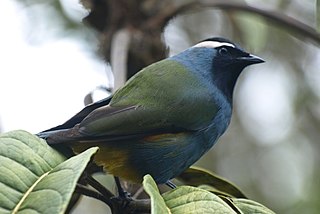
The painted berrypeckers, Paramythiidae, are a very small bird family restricted to the mountain forests of New Guinea. The family comprises three species in two genera: the tit berrypecker in Oreocharis, and the eastern crested berrypecker and western crested berrypecker in Paramythia. These are colourful medium-sized birds which feed on fruit and some insects. These species were formerly included in the Dicaeidae, but DNA–DNA hybridization studies showed these species were related to each other but distinct from the flowerpeckers. Some sources group painted berrypeckers as two genera belonging to the berrypecker family Melanocharitidae.

The olive whistler or olivaceous whistler, is a species of bird in the family Pachycephalidae, the whistlers, that is native to southeastern Australia.

The brown quail, also known as the swamp quail, silver quail and Tasmanian quail, is an Australasian true quail of the family Phasianidae. It is a small, ground-dwelling bird and is native to mainland Australia, Tasmania and Papua New Guinea and has been introduced to New Zealand and Fiji. Widespread and common throughout its large range, the brown quail is evaluated as being of "least concern" by the International Union for Conservation of Nature on the IUCN Red List of Threatened Species.
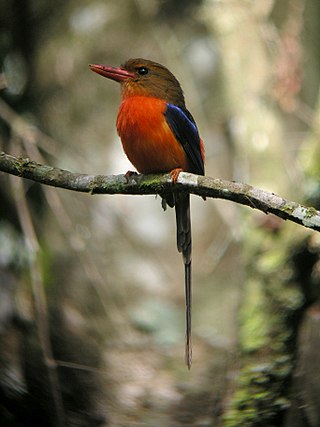
The paradise kingfishers are a group of tree kingfishers endemic to New Guinea — with the exception of two species also present in the Moluccas and Queensland.

The olive ibis is a species of ibis native to dense tropical forests in central Africa. Between 65 and 75 cm in length, it is a small ibis with olive plumage displaying an iridescent sheen. Four subspecies are recognized.

The mountain kingfisher is a species of bird in the subfamily Halcyoninae in the family Alcedinidae. Adult males are 21–24 cm (8.3–9.4 in) long, and have a rufous head and underparts, greenish-blue upperparts, a dark blue tail, and black flight feathers. They also have dark neck patches and loral patches. Females have dark crowns and the neck patches join at the nape. It is similar to the yellow-billed kingfisher, but can be distinguished by its larger size and a proportionally larger bill, along with a dark ridge along its culmen.

Amaurornis is a genus of birds in the rail family Rallidae. The species in this genus are typically called bush-hens. A monotypic subtribe, Amaurornithina, was proposed for this genus.

The plain bush-hen is a species of bird in the family Rallidae. It is endemic to the Philippines.
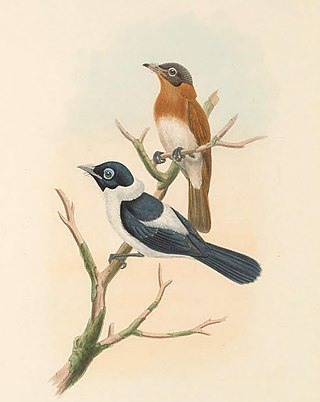
The frilled monarch is a species of bird in the family Monarchidae. As currently defined, its range is restricted to forest on New Guinea and nearby smaller islands, but historically it has included some or all of the remaining members of the genus Arses as subspecies.

Gerygone, the gerygones or peep-warblers, is a genus of bird in the family Acanthizidae. The genus ranges from Southeast Asia through New Guinea and Australia to New Zealand and the Chatham Islands. Most of the species are found in Australia and New Guinea; only one, the golden-bellied gerygone, has managed to cross Wallace's Line and colonise as far as Thailand, Malaysia and the Philippines.

The white-throated gerygone is a species of bird in the family Acanthizidae. It is found in Australia and Papua New Guinea. Its natural habitats are temperate forests and subtropical or tropical moist lowland forests. Its common names include white-throated warbler, white-throated flyeater, bush canary, and native canary.

The black monarch is a species of bird in the family Monarchidae. It is found in the New Guinea Highlands. Its natural habitats are subtropical or tropical moist lowland forest and subtropical or tropical moist montane forest.
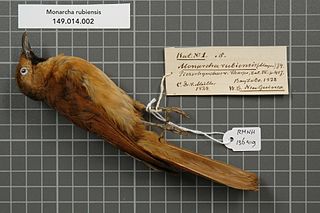
The rufous monarch, or rufous monarch flycatcher, is a species of bird in the family Monarchidae found in western New Guinea. Its natural habitat is subtropical or tropical moist lowland forests.

The olive sunbird is a species of sunbird found in a large part of Africa south of the Sahel. It prefers forested regions, and is absent from drier, more open regions such as the Horn of Africa and most of south-central and south-western Africa. It is sometimes placed in the genus Nectarinia.

The eastern crested berrypecker is a species of bird in the family Paramythiidae. It is commonly found in the high montane forests and shrublands of New Guinea. There are two subspecies, Paramythia montium montium and Paramythia montium brevicauda. The former inhabits the eastern portion of the New Guinea Highlands while the latter can be found in the Huon Peninsula. The western crested berrypecker was formerly considered conspecific but was split from it in 2021.
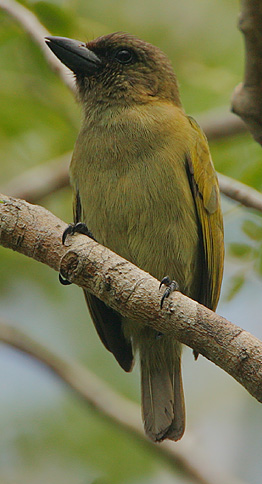
The green barbet is a species of bird in the Lybiidae family. It is found in Kenya, Tanzania, Malawi, Mozambique and South Africa. It occurs in forests from sea level to 1,800 metres (5,900 ft). Its isolated populations are vulnerable to forest clearing.

Paramythia is a genus of berrypecker in the family Paramythiidae.
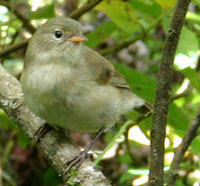
The green warbler-finch is a species of bird, one of Darwin's finches in the tanager family Thraupidae. Sometimes classified in the family Emberizidae, more recent studies have shown it to belong in the tanager family.

The olive marsh snake is a species of snake in the subfamily Natricinae of the family Colubridae. The species is endemic to Sub-Saharan Africa.


















